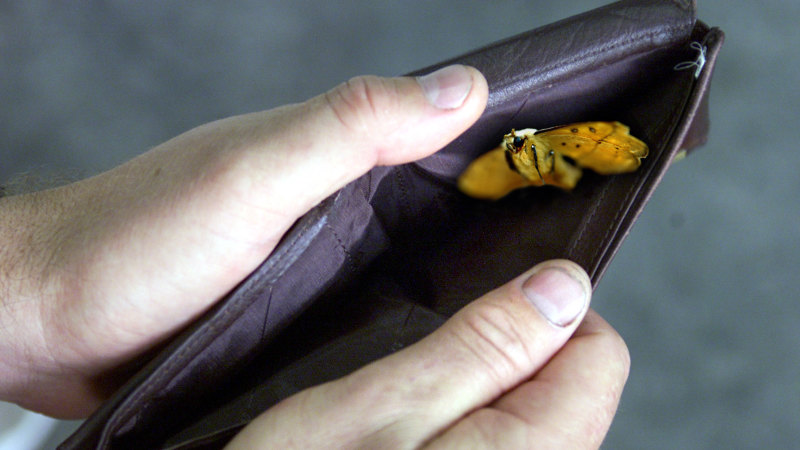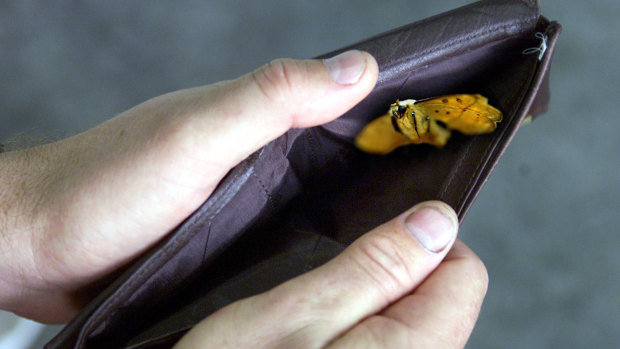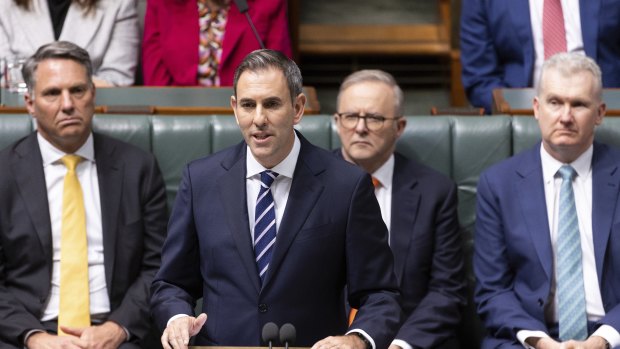Save articles for later
Add articles to your saved list and come back to them any time.
The Reserve Bank has conceded there is a chance the economy could shrink this year under the weight of inflation and its string of interest rate rises as households struggle to pay their mortgages and increasingly large tax bills.
As Westpac economists predicted Treasurer Jim Chalmers was on his way to delivering the first back-to-back budget surpluses since 2007-08, the RBA said households were likely to pay $1 of every $10 of their disposable income covering the interest bill on their home loans.
High interest rates, taxes and inflation will result in the economy struggling to avoid a recession this year.Credit: Tanya Lake
In its quarterly outlook on the economy released on Friday, the RBA slashed its forecast for growth this year to just 0.9 per cent. That would be the worst annual outcome for the economy, outside the COVID-19 pandemic, since the recession of 1990-91.
The 0.9 per cent forecast, down on the 1.2 per cent the bank was expecting three months ago, is the Reserve Bank’s central expectation. In a more detailed analysis, it found the economy could start contracting by year’s end and into 2024 if households failed to handle current interest rate settings.
The bank is hearing from community and charity organisations that many people, particularly low-income earners, are already struggling.
“Households, particularly those on lower incomes, [are] trading down to cheaper products and reducing basket sizes,” it said.
“People with jobs are now also seeking food support assistance more often than in the recent past, and higher interest rates have contributed to an increase in demand for services from people with a mortgage.”
The full impact on the economy of the RBA’s rate rises is evident in its changing forecasts. In November 2021, when the cash rate was a record-low 0.1 per cent, the bank was expecting the economy to grow by 2.5 per cent in 2023.
That forecast was sliced to 2 per cent in May last year, when the RBA first increased interest rates by a quarter of a percentage point. As recently as February, it was tipping the economy to expand by 1.6 per cent through 2023.
The bank has been concerned there could be an outbreak in wages growth, which would add to inflation in a so-called “wage-price” spiral. But the RBA, which said real wages had fallen 3 per cent over the past year, revealed it was yet to see such a development.
“There is no evidence from liaison of a higher share of firms linking wage outcomes to the CPI,” it said.
The RBA, along with central banks around the world, has driven up interest rates in response to high inflation. It is expecting price pressures to moderate, but estimates inflation won’t fall back within its 2-3 per cent target band until the second half of 2025.
The bank now believes risks are “evenly balanced” between inflation being higher or lower than its core forecast. Previously, it believed the risks were more likely for higher inflation.
High interest rates mean the bank expects more than 10 per cent of household disposable income will be spent on the interest on mortgages by next year.
Treasurer Jim Chalmers in May forecast a surplus of $4.2 billion for the 2022-23 budget. He is now on track for a $22 billion surplus and another surplus in 2023-24.Credit: Alex Ellinghausen
Home buyers who lifted their repayments or left cash in redraw accounts are now tapping that cash to make ends meet, with the bank reporting flows of money into these areas were now below their pre-pandemic levels.
Consumers are also being hurt by a surge in tax, partly due to higher wages growth, the end of the federal low- and middle-income tax offset and the effect of inflation on goods and services.
“Real incomes have been weighed down by continued high inflation, strong growth in tax payments and higher net interest payments, as well as declines in small business incomes,” it said.
It noted the stage three tax cuts, due to start from July 1 next year, would “support income and consumption”.
All of that extra tax is helping governments cover the deficits left by the pandemic. The biggest winner is shaping to be Chalmers, who has already confirmed a surplus of more than $20 billion is likely for the 2022-23 budget.
But Westpac senior economists Bill Evans and Andrew Hanlan said the revenue stream, and lower than expected spending, would result in Chalmers delivering a surplus for the current financial year as well.
They said the 2023-24 budget, rather than showing a deficit of $13.9 billion, was on track to be in the black to the tune of $11 billion.
In the following year, the budget would return to deficit, but was likely to be around $16 billion rather than the $35.1 billion Chalmers had forecast in May.
Evans and Hanlan said Chalmers was facing a “combined improvement in the cumulative budget positions over the three years of $62 billion”.
Cut through the noise of federal politics with news, views and expert analysis from Jacqueline Maley. Subscribers can sign up to our weekly Inside Politics newsletter here.
Most Viewed in Politics
From our partners
Source: Read Full Article


